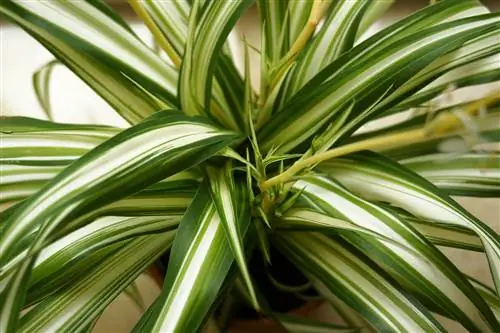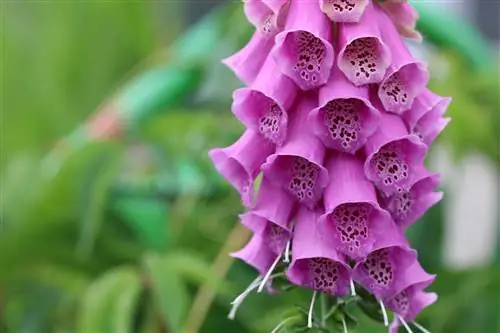- Author admin [email protected].
- Public 2023-12-17 03:39.
- Last modified 2025-01-24 12:45.
The spider plant (Chlorophytum comosum) is found in many homes and offices. It filters pollutants from the air, grows quickly and requires little care. Is the popular houseplant poisonous?
He althy properties
For a while the plant was considered old-fashioned. After its pollutant-filtering effect became known, it made it back into offices and homes. Indoor he alth experts recommend placing spider plants even in bedrooms because of their air-purifying properties.
Toxicity to humans?
The rumor has persisted for decades that spider plants are poisonous to humans. It quickly happens that small children put the leaves or a flower of the houseplant in their mouth.
However, the poison control center gives the all-clear and confirms that there is no danger to people from touching or eating plant parts. However, caution is advised if you have an allergy.
Toxicity to pets
Ingesting parts of the spider plant in a cat can lead to impaired consciousness, dizziness or apathy. Birds are sensitive to eating leaves in rooms with high levels of pollution. Dogs usually have no problems eating parts of the plant.
Note:
Please note that even non-toxic plants can contain residues from fertilizers, pesticides, etc.
Danger from pollutants and seeds
pollutants
The green plant filters pollutants from the indoor air. These are stored in the leaves. Normally, the concentration of the stored substances is not so high that it could pose a he alth risk to people or pets. However, it is possible that small children react sensitively. Even in pets, the dose can be enough to trigger an allergy.
Seeds
Green lilies produce delicate white flowers. Capsule fruits with seeds form from the flower. The seeds contain saponins, which are considered slightly poisonous.

Tips for protecting children and pets
- Place spider plants in a safe place so that children and pets are not tempted to nibble on the plant parts.
- Be careful not to let the seeds fall to the ground. The seeds pose a danger to small children. They are not highly toxic, but can cause symptoms in sensitive people. Cats, birds and small pets can also be harmed by eating the seeds.
- Put up cat grass for your cat. Domestic cats have the need to nibble on green leaves in order to better get rid of swallowed hair. When cats have a choice, they choose fresh, he althy cat grass.
- In newly renovated rooms or in rooms where people smoke, spider plants fulfill an important filter function. Be sure to place spider plants in these rooms to improve the air. Place them in places that are out of reach of children and cats.
Symptoms of poisoning in children
- Nausea
- Vomiting
- Diarrhea
- Vertigo
- paleness
- Disorders of consciousness
- Shortness of breath
- Hallucinations
First Aid
If you suspect poisoning, stay calm. Call an emergency doctor.
Symptoms of poisoning in pets
- Vomiting
- Diarrhea
- Trembling
- paleness
- Difficulty breathing
- unsteady walk
First Aid
See a veterinarian. To dilute the poison, give the animal water using a syringe.
Sources
www.gizbonn.de
www.katzen-leben.de
www.bvl.bund.de






